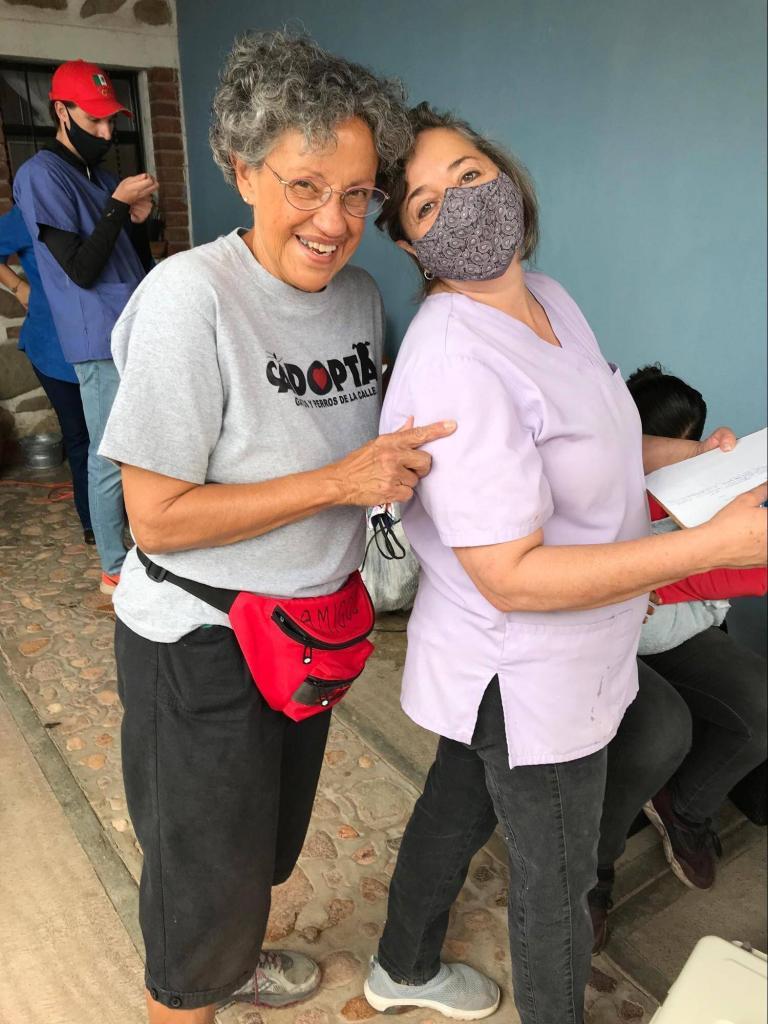Rosemarie Conde has been volunteering at the Amigos sterilization campaigns since August 2021. She learned about Amigos de los Animales in an email from a friend. Rosemarie contacted Sandra Ward, and it went from there. Now, besides heading the organization’s Sterilization Committee, Rosemarie serves on the Board of Directors.

She had years of experience in animal rescue work prior to volunteering with Amigos, and the messy parts of the sterilization campaigns did not bother her. Moreover, being an expat volunteer, she did not want to be “that gringa” who told other experienced people what to do.
Her first campaign
At her first campaign she washed and rinsed used surgical drapes in two plastic tubs, then hung them up to dry. There was no running water. (The cloth drapes are routinely washed immediately after being used. Later they are machine-laundered, folded, repackaged, and sterilized in an autoclave before being used again.)
That campaign took place in a small space. To Rosemarie, it felt like the team was doing far too many surgeries, close to 100, and the team worked until almost 8 pm. There were still people and pets waiting outside when she left. She ended up taking the prewashed surgical drapes home to launder in her washing machine.
How a typical campaign plays out
A campaign occurs when a local person sponsors an event. The sponsor finds the facility, advertises the campaign, provides food for our team, and is on site before the volunteers arrive. Usually, pet owners line up very early to await their turn, and the sponsor creates a list of those waiting in line.

When the Amigos volunteers arrive, they start weighing the dogs and cats, registering the owners, and assigning a number to each animal. The animal’s number, name, and weight are written on a piece of masking tape that is attached to its head.
Rosemarie takes the list of registered pets and has the owners fill out and sign a release form authorizing the surgery. Then the veterinarians call for the first animals to be prepared for surgery. There are usually three veterinarians at a campaign, two who perform the surgeries and a third who administers anesthesia. Often the surgical team includes several advanced veterinary students who perform their surgeries under the veterinarians’ supervision.
Reflecting on her first campaign, Rosemarie said it was a neat experience and she was amazed at the number of surgeries they had accomplished. In general, she added, the campaigns are a very impressive operation. The families who bring their dogs and cats to the campaigns and wait several hours—in some cases nearly all day—for the animals to be sterilized love their pets and really care about their welfare.
The volunteer team
Some volunteers, expats and Mexicans, come once or twice but don’t return. Others are regular volunteers who have become experts at performing specific tasks. By learning additional tasks, though, they can adjust as circumstances require to keep all the work from falling onto only one or two people’s shoulders. The volunteers work well together.
Rosemarie notes that jobs have evolved as the volunteers see things that need to be done or procedures can be improved. Cats are now operated on early during the campaigns because they awaken from anesthesia more slowly than dogs. The post-operative medications are now prepared when the animals are registered so that they are ready to be dispensed as soon as the patients are discharged from the recovery unit.
What keeps Rosemarie coming back to the campaigns is that she enjoys the work, meeting the people who bring their pets, and seeing how they care for their pets. Knowing that the cats and dogs are sterilized in a well-run operation performed by a congenial group of vets and volunteers is also very gratifying.
